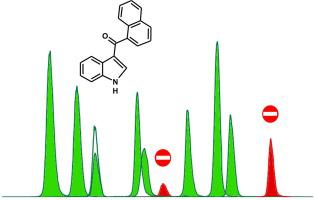Forensic Chemistry ( IF 2.6 ) Pub Date : 2021-02-13 , DOI: 10.1016/j.forc.2021.100317 Jens E.T. Andersen

|
Suppose that results of the scientific literature were presented in courts the same way they are presented in publications. In the present investigation, it is assumed that this is the case, and it is shown that it may potentially lead to issues with results that are being presented to the court. The determination of synthetic cannabinoids at low concentrations in blood, urine and other matrices is challenging to forensic science. Methods based upon the separation of the compounds by HPLC and detection by tandem mass spectrometry provides results at ultra-low concentrations. The uncertainty of measurements has become the key parameter of interest for decision making, and expert witnesses need to state the correct level of uncertainty. Recent developments in quality assurance indicate issues with reliability, owing to contradictory statements that originate from different methods of data management and interpretation of results that eventually may lead to compromising the truth. The levels of relative uncertainty of measurement that were close to 5% were found to be unrealistically low when synthetic cannabinoids were analysed at ultra-low concentrations. It was proposed to introduce the principle of pooled calibrations to obtain correspondence between predicted and observed uncertainty, following standards of scientific methodology. Ten synthetic cannabinoids were analysed with pooled calibrations, and the results indicated that the uncertainty of measurement was found at levels much higher than expected, and with two out of ten synthetic cannabinoids that were impossible to quantify with relative uncertainties reaching levels over 70%.
中文翻译:

在法医背景下使用纵向校准数据评估测量不确定度
假设科学文献的结果在法庭上的呈现方式与出版物中的呈现方式相同。在本次调查中,假定情况确实如此,并且表明可能会导致正在向法院提出结果的问题。血液,尿液和其他基质中低浓度的合成大麻素的测定对法医学具有挑战性。基于HPLC分离化合物并通过串联质谱检测的方法可提供超低浓度的结果。测量的不确定性已成为决策感兴趣的关键参数,专家证人需要陈述正确的不确定性水平。质量保证方面的最新进展表明存在可靠性问题,由于源自不同数据管理方法和结果解释的矛盾陈述最终可能导致损害事实真相。当以超低浓度分析合成大麻素时,发现相对测量不确定度接近5%,这是不现实的低。有人建议按照科学方法学的标准引入合并校准的原理,以获得预测的不确定性和观察到的不确定性之间的对应关系。用汇总校准分析了10种合成大麻素,结果表明发现的测量不确定度远高于预期水平,十分之二的合成大麻素无法定量,相对不确定度达到70%以上。











































 京公网安备 11010802027423号
京公网安备 11010802027423号